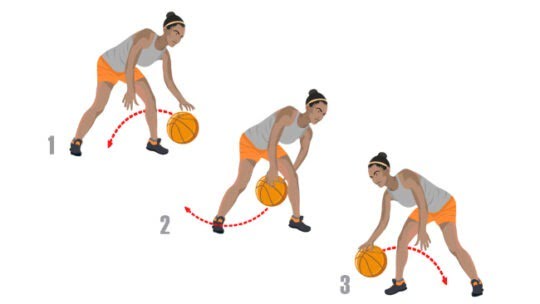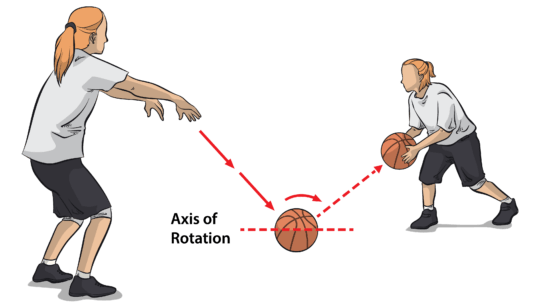Basketball Control Drills And Passing
There are 30 seconds left in the game, and you need to burn the clock out. This is where you need to protect the ball from being checked from your hand and stolen. It must be crisp and accurate if you need to make a pass.
These are skills that, once mastered, make you a better player on the court. They often go overlooked for their showboating antics and trash-talking. Trust me when I say being able to dance circles around your opponent with the ball is all the trash-talking you need to do.
Having control of the game requires players who can control the ball. It is essential that dribbling and passing are fundamental drills. You take the time to learn and learn well.
Ball Control and Passing
Dribbling
This seems like a grade-school lesson to teach, but as we mentioned before, being a good dribbler is paramount to being the best basketball player you can be. If you watch the top ball-control players in the NBA, they have control of their dribble and can make the ball go anywhere they want.
It’s like the ball is on the end of a string – it goes between their legs, in either hand, around the back, and it rarely gets away from them, but it’s always out of the opponent’s reach.
We’ve all played against the point guard who has spent much time ensuring his ball-control skills were excellent. They frustrate you and force you to make stupid mistakes simply because they can keep the ball away from you.
So what are the two basics to being a good – no great – dribbler?
Control
I suggest making sure you are in control at all times. Nothing is worse than a player who thinks he or she can dribble around anyone and anything, only to lose it because they lost control and had it stolen.
Always maintain your poise when dribbling. After considerable practice, you can execute all of the more advanced dribbling skills without looking at the ball and being worried about losing it to your opponent.
Balance
This goes hand in hand with control. Along with the ball, you have to have control of your body to maintain reasonable control of the ball. Work on maintaining solid footwork and ensuring your body is squarely over your feet.
Proper Technique
Whether you are streaking the court or protecting the dribble near the baseline, you need to consider how you are bouncing the ball. Are you bouncing it too high and out in the middle of the court? Or are you bouncing it too far in front of you?
Here are some pointers for Dribbling:
- When running down the court, it is safe to dribble the ball ahead of you, but make sure you are dribbling in stride – don’t chase the ball. Also, make sure you are dribbling it at about waist height and no more. The higher the ball travels, the easier it is to steal.
- If you are stationary, keep the ball just above knee height. Place your non-dribbling side foot slightly ahead of your other foot and use your body to shield another player from coming across to steal it. With one foot ahead, you can also quickly pass the ball through your legs to the other hand. Protecting the ball while standing still is the most critical thing to remember.
- Try to keep your head up. It will take practice to become more comfortable, but it will pay dividends in the end. Believe it or not, it is easier to steal the ball away from someone not looking up than from a player who is watching what you are doing. This also makes it easier for you to execute a quick pass.
- Practice your advanced moves. This is not showboating; don’t let anyone tell you otherwise. Keeping the ball away from an opponent while protecting it and possibly moving past it is worth learning and executing.
- Don’t slap at the ball when you are dribbling. You have no control over where the ball is going. Use the palm of your hand and the fingertips to maintain control of the basketball.
Drills and practice for dribbling:
If you want to be a better dribbler, take that basketball wherever you go. Dribble with it to school, in the driveway, to your friend’s house – anywhere!
Other than shooting, dribbling well takes the most practice of any basketball skill to perfect. Any chance you get to bounce the ball, bounce it.
At the park
Take some time before you start shooting to move around the court leisurely, dribbling into different positions. Please don’t do it at full speed until you can get the hang of the comfort of dribbling the ball. Go half-speed and bounce the ball through your legs to the other hand.
Do the same if you want to go behind the back. Maintain your footwork and balance; before you know it, you will naturally be doing these things at full speed when you are playing against your friends in the park or on the court for a game.
Also, make sure you take the time to practice with your opposite hand. Nothing is worse than watching a right-handed player try to drive to the left-hand side of the basketball hoop and have the ball swatted from their reach because they couldn’t protect the ball on the left side of their body.
Here’s a drill to use both hands and get used to the transition between each of them:
- Place your legs one in front of the other (whichever side you are the most comfortable putting the ball through first)
- Make sure you have good balance and a sturdy stance.
- Bounce the ball twice at about knee height, then put the ball in your other hand on the third bounce without moving the rest of your body. Bounce twice, and return it to your other hand on the third bounce.
- Continue doing this drill until you can look straight up and ahead of yourself without looking at where the ball is going. For this drill to be successful, you need to be able to dribble the ball without looking at it.
Try switching which leg is ahead and which is behind because you will likely be faced with the situation where you need to reverse the above drill in the face of game action.
A variation of that drill is to look straight ahead with your legs one ahead of the other and just one bounce between the legs each time a hand touches the ball. Another way to do it is to try and walk along the basketball court and, with each stride, put the ball through your legs.
The hot potato is another good drill to increase the speed and coordination of your hands. You’ve probably seen the Harlem Globetrotters use this one during the middle of a game.
Dribble the ball low to the ground – I mean real low – and push it quickly to the ground, exchanging hands each time you touch it. You should be able to get so quick at this drill that the ball will hit the ground twice or thrice a second.
Passing
We’ve all been guilty of bad passes on the basketball court, whether because of bad timing or bad passing. There are a few things that you can work on to make sure you aren’t the culprit when a ball is turned over because of a bad pass.
The basics of being a good passer are accuracy, anticipation, and timing. Each of these is important to master in the types of passes – chest pass, bounce pass, baseball pass, and the ever-popular dish-off.
The chest pass (or push pass) and the bounce pass should be the passes you regularly choose because the baseball pass is often erratic and costly on the turnover side of the score sheet, and the dish is a lower percentage play.
Here are some pointers to help you with your passing:
- Pass to where your teammates should be, not where they are. If they are moving, putting the ball behind them does no good. The chance of a trailing defender intercepting the pass is much greater if the passer doesn’t lead with the ball.
- Try to anticipate where your players will end up during a play. If you are trying to get them the ball, they should keep their head up waiting for a pass. You might hit them in the head several times before they get the gist. Anticipation is one of the basic instincts a guard or small forward can develop for their passing skills.
- Ensure you are timing your passes to reach your teammate when they are making their cut. It goes hand in hand with anticipation. Once you anticipate, ensure the ball gets there when the play develops.
- Fake with the ball. In most situations, you aren’t free of a defender in your face or stuck like glue to your teammate. It would help if you got in the habit of faking a pass before making one. “Fake before you make” is the mantra of a solid passer. Fake a bounce pass before making a chest pass, and vice versa. You create a more apparent passing lane with the fake, ensuring the ball will reach your teammate.
- Always hold on to and pass the ball with two hands. Even with a bounce pass, to avoid having the ball slapped from your hands, keep both hands securely on the ball
Proper Technique
With all passes, there should be a standard positioning to ensure you get the power and accuracy behind the ball when you go to pass.
- Stand with your feet shoulder-width apart, one slightly ahead of the other.
- Both hands should be on the ball.
- Just like baseball, lead with your feet. It’s just that in basketball, you should lead with the foot on the side you are passing to.
- Always be looking up. Don’t try to pass the ball with your head buried in the sand.
Other ball control tips:
- If you or your team is trying to kill extended periods, short quick passes will keep your opponent running and keep them guessing. Just follow the techniques above, and you will keep them at bay.
- Know the rules and how to use them to your advantage. It might be a good idea when you are trying to kill time, if you are hammering a team on the boards, to take a shot or two now and then. The 30-second clock resets every time a shot hits the rim. If you can snag the rebound, you bought yourself another half-minute
- Don’t try to dribble through and around everybody to wind the clock down. Your teammates are your allies – make the pass.



